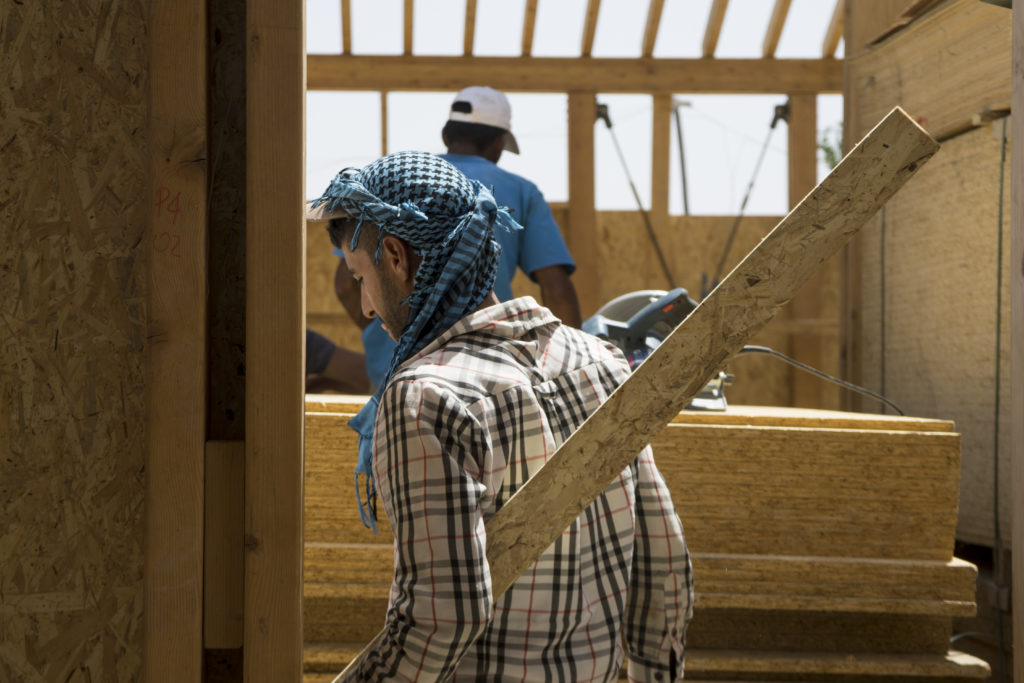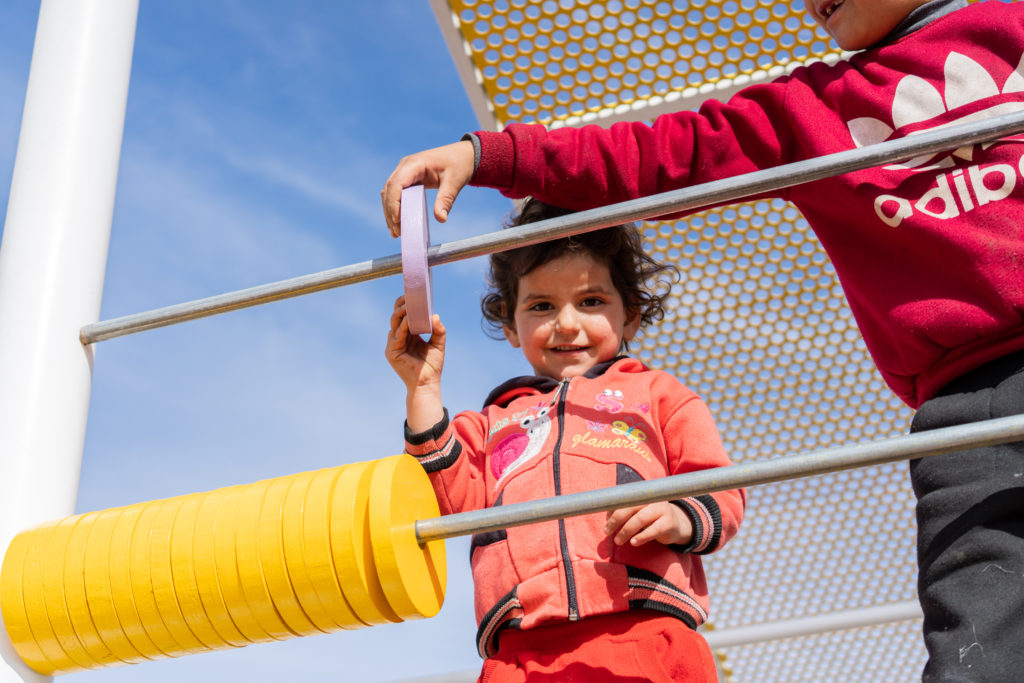
Key points
The choice of materials and technologies can generate positive impact and empower the local community.
Purchasing materials locally, hiring local labour and adopting context appropriate technologies can contribute to boosting the local economy and improving social cohesion.
The choice of materials and technologies will have an impact on the environment and the health of workers.
Building materials tend to utilise a large part of the budget for built interventions. Paying particular attention to the choice of materials during the design process can maximise the positive impact generated.
In most design processes, material choices are guided by:
- Aesthetics;
- Functionality;
- Affordability.
When working with vulnerable communities in a context of displacement, other aspects should also be considered when choosing the materials. These vary depending on the intervention itself, and the values of the implementing organisation or designer. Below are some examples.

Local materials, skills, technologies
Guiding questions:
Is the selected material available locally?
Is there local labour with the experience and skills to work with this material?
What is the level of expertise available for working with this material? (e.g. high level = complex techniques available for processing the material)
What cultural meanings are attached to particular materials/construction techniques by displaced and host communities?
Choosing a local material provides income for local businesses, which can generate multiple benefits:
- Boosting the local economy
In contexts of displacement, built interventions are often located in vulnerable areas where businesses would benefit from the additional income that a built intervention generates. Importing building materials from abroad or from other locations would be a missed opportunity to help local businesses thrive.
- Improving social cohesion
This is particularly pertinent when there are existing tensions between the community for whom the built intervention is implemented, and other local communities (e.g. between refugees and host communities; more established refugees and the newly arrived; newly arrived refugees of different nationalities). Purchasing from local businesses can provide tangible proof of positive impact, even if the built intervention will then be used by another community.
- Allowing easy and sustainable maintenance
Are materials and skills for maintenance available within a short distance of the intervention site?
The designer might be able to suggest innovative ways of using or processing a material which offers additional benefits, this could include upcycling wasted materials. Delivering context-specific innovations that can be replicated by the community without external input contributes to building local capacity. The intervention itself could centre around a technology to process, assemble, or install a material, and can have benefits in terms of health, the environment, durability, costs, etc. processing a material which offers additional benefits, this could include upcycling wasted materials. Delivering context-specific innovations that can be replicated by the community without external input contributes to building local capacity. The intervention itself could centre around a technology to process, assemble, or install a material, and can have benefits in terms of health, the environment, durability, costs, etc.
Empowerment
Choosing building materials carefully can generate opportunities for empowerment within the construction process. Below are two examples of empowerment that can result from a well-considered choice of materials.
- Empowering unskilled labourers
Choosing materials that do not require a high level of specialisation provides opportunities for unskilled labourers to work on the construction, and to acquire new skills from working alongside skilled workers. This can extend to youths who could participate in the construction phase through a structured apprenticeship program.
- Empowering children
Choosing materials that are safe for children to use during the construction phase may allow children to play an active role through structured activities with facilitators. Such engagement would strengthen children’s participation within a project and increase their sense of ownership, which contributes to the long-term sustainability of the intervention.
- Empowering women
In some contexts, women may be excluded from the construction process. Choosing appropriate building materials and design components can help to facilitate women’s participation, and can generate empowerment by offering livelihood opportunities and challenging notions of this being a male sector.
The same thinking can be applied to other excluded groups that the intervention aims to empower.

Environment
The building materials used in a built intervention have an impact on the environment, both through their production process and their use on site. When working with displaced communities, built interventions may be temporary by design. If this is the case, building materials that can be reused at the end of the life cycle of the building would be preferable.
Another way to reduce the environmental impact of a built intervention is to use recycled materials. This can present good opportunities for upcycling wasted materials, creating inspiring ideas for the local community. Giving a value to waste can also have great economic impact and raise awareness around issues of waste management/recycling.
Health
Building materials can often pose health threats to the people handling them. For example, they may be toxic if handled without adequate personal protective equipment (PPE). Therefore, when working in contexts where there is low awareness of the hazards of wrongly handling building materials, it is best to choose materials that do not pose such threats.
This is even more important when caregivers and children are involved in construction. Such considerations should extend to three areas linked to materials:
- Sourcing
Considering how the material is sourced implies understanding how it
is sourced from nature. This is a lengthy and complex process that can hardly be achieved in its entirety. Locally, this requires an understanding of how the material is stored and handed over to buyers. If those providing a material are currently facing difficulties, it may be better to choose a different material. For example, if the production industry of a certain material is known to exploit workers (unfair pay, unsafe working conditions, job insecurity, excessive working hours), it should be avoided unless the exploitation issue can be addressed.
- Processing
Designers must also consider how they will use the material and the process of transforming the raw material into the final product. What are the hazards that labourers will be exposed to when processing this material? Keeping hazards to a minimum helps to guarantee everyone’s wellbeing during the construction process. The Provision of Personal Protective Equipment (PPE) should not be taken for granted (see step 9.2 – Management of building works). PPE can limit hazards, but often training around its proper use must first be conducted. For example, the designer might choose to treat wood with a specific paint for aesthetic reasons. If this paint is toxic and requires specialised PPE that is not easily found locally, it may be best to choose a different paint, as the health risks for handling this material without proper use of PPE are high.
- Assembling and installation
Similar to processing a material, it is important to think about how a material will be used to make the components to be installed on site.
How will the installation take place? What are the hazards linked to the installation? Is there any way to design a solution to reduce these hazards? For example, steel can be assembled through welding or through bolting. As welding poses more hazards than bolting, designing bolted connections for steel components is safer.
- Use
When choosing materials to construct spaces for children, it is important to think about the safety of those materials during use. Are there any hazards for children when they touch exposed materials? For example, is there any paint that is toxic for children? Are there any sharp/rough surfaces that could cause injury? Materials should also be safe long-term with minimal maintenance.
Specific materials, and construction techniques, may have cultural meanings and uses in displaced and host communities. This means that local, familiar materials for the host community may be inappropriate for the displaced people, or that they may be unfamiliar with the construction techniques involved. Moreover, a material which may have good properties in terms of cost, availability and environmental sustainability may be considered to be poor quality, or “backwards”. This could affect its use or attitudes towards the intervention.
When selecting building materials, it is important to make informed choices about what aspects to value most when facing time and budget constraints.
One way to address time constraints may be for designers and organisations to build a database of materials and suppliers. This could be compiled and updated across different projects and shared between actors operating in similar contexts. Built environment professionals with experience in interventions can share their knowledge of available materials, sourcing processes and techniques.



